Although there is still a long list of items that need to be fixed before the new police station can be used, police and city officials are pleased as punch about it.
This is the first upgrade since the station was constructed along with the building in 1971, and all of it has been paid for by money confiscated by the police in the line of duty.
“This was all paid for by seized drug money or money seized as result of criminal activity,” said Police Chief Ralph Scianni. “Not a dime comes from taxpayers.”
The project that was started under former Chief Robert Kubert upgraded the working area, which in the past was largely comprised of a large square walled in by counters, a window looking out of a small entrance area, a glass holding cell and a series of rooms, offices and records areas beyond these.
The modernization has resulted in a number of security changes, including the way the public interacts with those inside, modern monitors to keep track of everything, and computer consoles to allow police on duty access to a significant amount of additional information.
The piles of paper work – which still exist, of course – were replaced in a number of areas by more modern computer files.
Most importantly, instead of a wooden door with a punch code to access, the doors in the new station make use of access cards, identifying who is entering what portion of the station. Security for people coming to the station to talk with police has also increased.
In the past, someone with a problem would crowd into a small area with three plastic chairs and wait his or her turn to talk to the receptionist. Sometimes this forced people to crowd into a corner and explain their issue in hushed whispers only a few feet from others waiting for accident or other reports, or for background checks.
The new facility will provide two spaces, including a secure area beyond the public access area where police can talk to them through a panel of bulletproof glass about what issues they need to speak confidentially.
There are two interrogation rooms, each self contained and secure, Scianni said.
Security cells for prisoners provide more privacy and better security as well, as do the hallways leading to and from them.
Although locked doors sometimes kept offices separated from the outside, in the past, access was possible from one part of the station to the other. Officers inside the station were also vulnerable because everything was open.
Prisoners in the past were brought in through the garage area on the 27th Street side of the building, but internal improvements now allow access to the elevator and less exposure to public that might be accessing the building on business unrelated to police activities.
Camera arrays throughout the building also provide security for all of City Hall, where the police station is located.
“This was all paid for by seized drug money or money seized as result of criminal activity.” – Police Chief Ralph Scianni
__________
New layout for safer, more efficient work
New information technology will improve the accuracy of reports, Scianni said.
Along with the desk area, which has vanished entirely to become a series of rooms, there is now one main area with consoles and monitors, a kitchen area, and bathroom and shower facilities for the increasing number of female employees. In the past, the department had no facilities for women.
The break room used to be a closet, Scianni said.
One of the larger rooms that served a number of purposes was also upgraded, and will serve as a line-up room and a meeting room, as well as a room for other activities.
Many of the changes are dramatic. Gone is the dingy yellowed look straight out of a 1970s crime drama. It has been replaced by a very modern, almost military-like appearance, with gray walls and sharp lighting. It is now filled with energy-saving fixtures that will help reduce the overall costs of operations.
The work started in April 2012. One of the almost herculean tasks involved the replacement of cables and other wiring to accommodate the new modern equipment. Ceilings filled with old wire had to be tracked and replaced, often forcing work into areas of the station not yet set for the upgrade.
Everything had to be traced and coded, the chief said.
This coincides with the opening of the emergency operation center. That is something so modern and state-of-the-art that it provides Bayonne with the ability to track and deal with nearly any major disaster, terroristic threat, or storm.
The emergency operation center includes a big screen, real-time feeds from satellites, and a conference area where all the key players can gather.
The communication center was built in an earlier phase of upgrades after unused jail cells were removed, and built using a $600,000 grant from the Federal Department of Justice.
The cells were no longer needed because long-term prisoners are now sent to the Hudson County Correctional Facility in Kearny.
The communication center provides backup system as well, said Public Safety Director Jason O’Donnell.
This is a kind of room you might find in Washington, D.C., and where the police department, emergency medical services, fire department, Office of Emergency Management and other vital groups needed in an emergency can gather, have access to information, share ideas and come to consensus on what to do in a given emergency, O’Donnell said.
It is a self-contained unit with its own personnel, backup power, and handicap accessibility.
